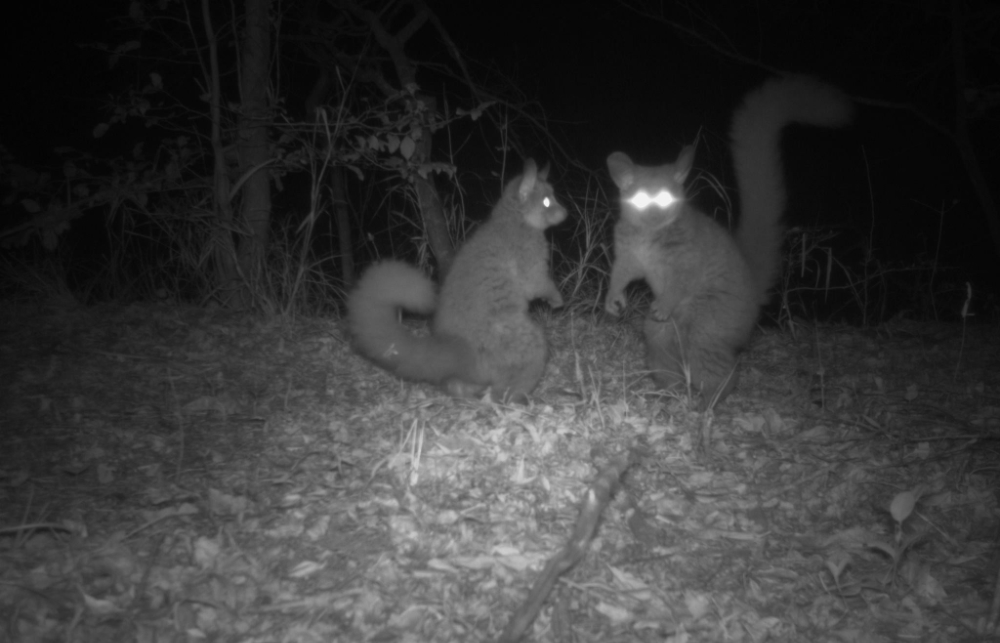Laetitia Confuron PhD thesis
 Quantitative study of vocalization and soundscape ecology
Quantitative study of vocalization and soundscape ecology
Started in october 2024
Funding: École pratique des hautes études
Supervisor: Sébastien Couette
Abstract
 Understanding the evolution of communication systems in primates is essential for understanding the cognitive and social mechanisms involved in their adaptation to complex environments. In nocturnal species such as Otolemur crassicaudatus, vocalization becomes a central communication channel, at the crossroads of ecological, morphological and social pressures. Yet these species remain largely understudied in comparative approaches. This PhD takes an original look at how vocal signals develop and change in this strepsirrhine primate in response to environmental structure, social organization and sensory constraints specific to nocturnal life. It aims to i) analyze the link between the morphology of the vocal and auditory apparatus and sound production/perception, ii) characterize the vocal repertoire by identifying individual and functional variations using artificial intelligence tools, iii) test recognition, preference and discrimination abilities through experimental playbacks, and iv) study the effect of the sound environment (soundscape, ambient noise, presence of sympatric species) on signal propagation, using field measurements and LiDAR modeling.
Understanding the evolution of communication systems in primates is essential for understanding the cognitive and social mechanisms involved in their adaptation to complex environments. In nocturnal species such as Otolemur crassicaudatus, vocalization becomes a central communication channel, at the crossroads of ecological, morphological and social pressures. Yet these species remain largely understudied in comparative approaches. This PhD takes an original look at how vocal signals develop and change in this strepsirrhine primate in response to environmental structure, social organization and sensory constraints specific to nocturnal life. It aims to i) analyze the link between the morphology of the vocal and auditory apparatus and sound production/perception, ii) characterize the vocal repertoire by identifying individual and functional variations using artificial intelligence tools, iii) test recognition, preference and discrimination abilities through experimental playbacks, and iv) study the effect of the sound environment (soundscape, ambient noise, presence of sympatric species) on signal propagation, using field measurements and LiDAR modeling.
Keywords
Bioacoustic – Animal communication – Strepsirrhini primate
Thesis advisory panel
Claire Dufour
Cédric Girard-Buttoz
Jérôme Sueur
- extrait:
- lien_externe:
- titre:
- Étude quantitative des communications vocales et de l’acoustique de l’habitat
- date_de_debut_these:
- octobre 2024
- nom:
- COnfuron
- date_de_debut_these_numerique:
- 202410
- kc_data:
- a:8:{i:0;s:0:"";s:4:"mode";s:0:"";s:3:"css";s:0:"";s:9:"max_width";s:0:"";s:7:"classes";s:0:"";s:9:"thumbnail";s:0:"";s:9:"collapsed";s:0:"";s:9:"optimized";s:0:"";}
- kc_raw_content:
 Quantitative study of vocalization and soundscape ecology
Quantitative study of vocalization and soundscape ecologyStarted in october 2024
Funding: École pratique des hautes études
Supervisor: Sébastien Couette
Abstract
 Understanding the evolution of communication systems in primates is essential for understanding the cognitive and social mechanisms involved in their adaptation to complex environments. In nocturnal species such as Otolemur crassicaudatus, vocalization becomes a central communication channel, at the crossroads of ecological, morphological and social pressures. Yet these species remain largely understudied in comparative approaches. This PhD takes an original look at how vocal signals develop and change in this strepsirrhine primate in response to environmental structure, social organization and sensory constraints specific to nocturnal life. It aims to i) analyze the link between the morphology of the vocal and auditory apparatus and sound production/perception, ii) characterize the vocal repertoire by identifying individual and functional variations using artificial intelligence tools, iii) test recognition, preference and discrimination abilities through experimental playbacks, and iv) study the effect of the sound environment (soundscape, ambient noise, presence of sympatric species) on signal propagation, using field measurements and LiDAR modeling.
Understanding the evolution of communication systems in primates is essential for understanding the cognitive and social mechanisms involved in their adaptation to complex environments. In nocturnal species such as Otolemur crassicaudatus, vocalization becomes a central communication channel, at the crossroads of ecological, morphological and social pressures. Yet these species remain largely understudied in comparative approaches. This PhD takes an original look at how vocal signals develop and change in this strepsirrhine primate in response to environmental structure, social organization and sensory constraints specific to nocturnal life. It aims to i) analyze the link between the morphology of the vocal and auditory apparatus and sound production/perception, ii) characterize the vocal repertoire by identifying individual and functional variations using artificial intelligence tools, iii) test recognition, preference and discrimination abilities through experimental playbacks, and iv) study the effect of the sound environment (soundscape, ambient noise, presence of sympatric species) on signal propagation, using field measurements and LiDAR modeling.Keywords
Bioacoustic – Animal communication – Strepsirrhini primate
Thesis advisory panel
Claire Dufour
Cédric Girard-Buttoz
Jérôme Sueur
